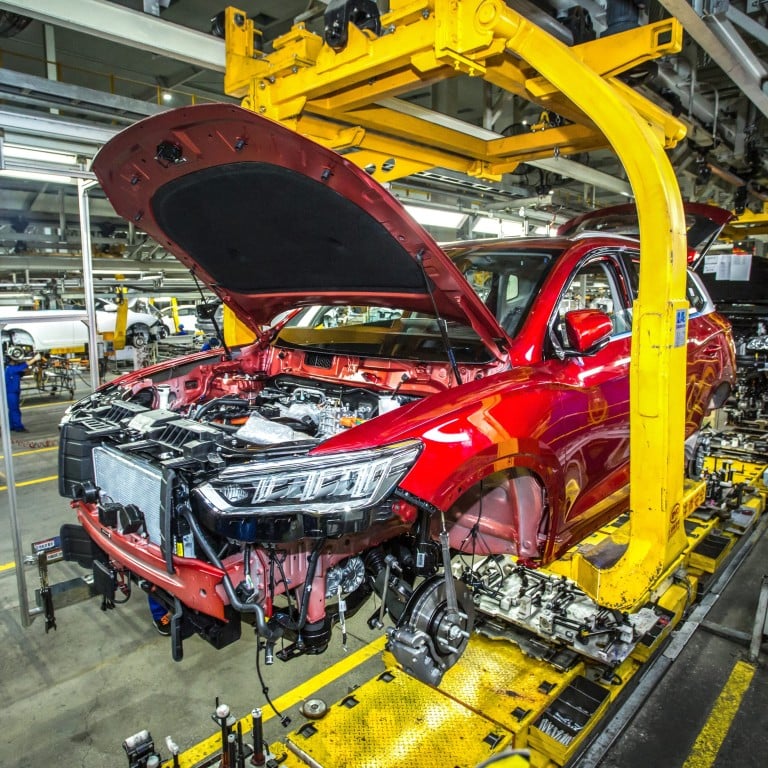
Shenzhen in cross hairs of US tech curbs, but Huawei’s home still tops Beijing and Shanghai in first-quarter growth
- The southern Chinese city of Shenzhen reported year-on-year economic growth of 6.5 per cent in the first quarter of 2023, beating Shanghai and Beijing
- Shenzhen is the home of electric vehicle manufacturer BYD, tech giant Huawei Technologies, internet services firm Tencent and drone maker DJI
China’s Silicon Valley posted the highest economic growth among top-tier mainland cities in the first quarter, underlining Shenzhen’s tenacity and strength in the face of intensifying pressure from the United States to contain the nation’s tech development.
Driven by stronger-than-expected growth in the electric vehicle sector, the home city of BYD reported year-on-year economic growth of 6.5 per cent in the first quarter, beating Shanghai and Beijing, after its gross domestic product (GDP) reached 777.2 billion yuan (US$112.5 billion) in the first three months of the year.
Its strong performance offers China’s tech industry hope that it can withstand the relentless pressure from Washington, which has continued to impose restrictions on its technology exports since the start of the year, with the Shenzhen-based Huawei Technologies at the centre of the curbs.
With the increasingly hostile regulatory system … it is not fully clear whether private entrepreneurs will be as incentivised as in the past to innovate.
Alicia Garcia-Herrero, the chief economist for Asia-Pacific at Natixis, said Shenzhen clearly has “huge potential” in terms of advanced technology and biotech, but its success also depends on “two local factors” that go beyond the “usual suspect” of US containment.
“[The first factor is] the Chinese government capacity to continue to support innovation financially, given that the public debt has really ballooned and that local governments are much more cash strapped,” she said.
“The second factor, which is very important, is the private sector’s incentives to innovate.
“With the increasingly hostile regulatory system – whether it is national security or data requirements – it is not fully clear whether private entrepreneurs will be as incentivised as in the past to innovate.”
Some analysts, though, cautioned that it was too early to judge based on one quarter’s figures and pointed out that Shenzhen still faced challenges on its fast-growing advanced technology development path.
But this is the first sign of the city’s strong recovery after China ended its strict coronavirus control measures, putting Shenzhen in a strong position to lead the integration of the Greater Bay Area, which Beijing sees as an important engine to drive the nationwide economic upgrading.
The Greater Bay Area is the Chinese government’s scheme to link the cities of Hong Kong, Macau, Guangzhou, Shenzhen, Zhuhai, Foshan, Zhongshan, Dongguan, Huizhou, Jiangmen and Zhaoqing into an integrated economic and business hub.
Peng Peng, the executive chairman at the Guangdong Society of Reform, said Shenzhen has the advantage of being situated in the Pearl River Delta manufacturing hub next to a global city like Hong Kong, but still cautioned that external challenges remain.
Trade and technology wars will bring along a series of other issues that make [Shenzhen’s] independent development difficult
“Trade and technology wars will bring along a series of other issues that make [Shenzhen’s] independent development difficult,” he said.
“The suppression of the US and the West could lead to the disruption of supply chains. And there is not enough fundamental research on chips and mask aligner.”
Beijing’s GDP, meanwhile, increased by 3.1 per cent to 995 billion yuan, while Guangzhou – the provincial capital of Guangdong province – saw its economy rise by only 1.8 per cent, year on year, to 696.4 billion yuan.
“Unlike most other cities with deep history and pride, people converge in Shenzhen with a single goal to seek economic advancement, which is a key driver for Shenzhen’s economy,” said Hugh Chow, a 30-year global executive in technology and a partner at the Greater Bay Area-based Radiant Tech Ventures.
Shenzhen is now committed to creating a whole-process innovation ecological chain that is made up of basic and technical research, industrialisation of achievements, technology finance and talent support to form a market-oriented technological innovation system with policy support, according to information from Hong Kong Trade and Development Council.
With enterprises as “the main body”, Shenzhen aims to feature integration of production, education and research, the council added by pointing to to the likes of Huawei Technologies, BYD, Tencent and DJI that have established their headquarters in Shenzhen.
Yuan Chenjie, the principal representative at private equity firm SAIF Partners, said that Shenzhen needs to figure out “a completely different path” to catch up with or even surpass the Shanghai-centred Yangtze River Delta.
The leading spots of growing hi-tech firms are Jiangsu, Shanghai and Zhejiang, which have outpaced the Pearl River Delta
“The leading spots of growing hi-tech firms are Jiangsu, Shanghai and Zhejiang, which have outpaced the Pearl River Delta,” said Yuan.
Shenzhen’s industrial value-added manufacturing increased by 4.5 per cent year on year in the first quarter, compared to a fall of 3.3 per cent in Shanghai.
“Shenzhen is working hard to pull in top universities, such as Sun Yat-sen University, Harbin Institute of Technology, Xi’an Jiaotong University,” Yuan added.
“At the same time, Shenzhen can collaborate with Hong Kong’s universities to develop technological research, which is a unique advantage.”
But Radiant Tech Ventures’ Chow said that the rising “unilateral restrictions” the US has placed on advanced technologies will hinder China’s development.
“Some may argue that such decoupling may cost the US even more in the long term,” he added.
“One thing is clear, however, is that the period of globalisation over the past 30 years is slowly coming to an end.
“The chance is that China will continue to find a way,” Chow added, citing Shenzhen’s “special charm” with its fast expansion of the electric vehicle, solar panel and lithium battery sectors.
During a local technology forum last month, the local government noted that biotechnology, as well as brain science and technology, will become future pillar industries, with some projects already under development at a science park in its Guangming district.
From AI to IoT, 4 areas where China’s smart cities are making a difference
Shenzhen has also rolled out incentives to attract talent, such as an easier settlement policy and generous start-up subsidies, to help alleviate the city’s shortage of skilled personnel compared to Beijing and Shanghai.
According to a survey released by economist Ren Zeping on the attractiveness of Chinese cities for talent in 2022, Shenzhen ranked second after Beijing due to its advanced technology industry, while it ranked first in terms of innovation with the highest number of patents granted per 10,000 people.
Despite limitations, Shenzhen has been standing out among other cities in the Greater Bay Area for being the innovation hub of the region, while Hong Kong is set to serve a complementary role amid the transformative technological development.
Alice Tsang, principal economist for global research at the Hong Kong Trade and Development Council, said that Hong Kong “is an important biotech gateway to the Greater Bay Area” as it facilitates foreign manufacturers of proprietary Chinese medicine products, medical devices and drugs.



